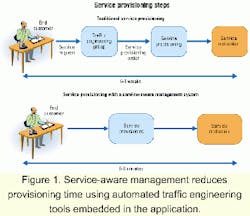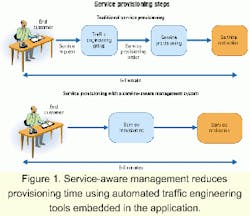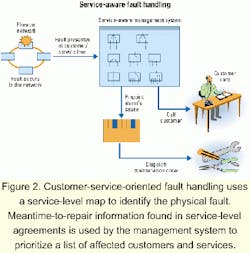The new management paradigm is all about service
Network management moves from just the physical layer to service-aware management systems.
ELI ERLICH, Native Networks Technologies
Stiff competition in telecommunications is breeding a new set of value-added services. Provisioning of these services requires advances in equipment and technologies. As this new equipment enters the metro and access arenas, it's clear that the equipment and technology alone are not enough, and sophisticated network-management systems must follow suit.
Existing management solutions focus on the physical aspects of the network and the maintenance of reliable connectivity. These management systems, commonly found in the management of SONET/ SDH networks, require high-level expertise in network engineering and planning.
Network management can be transformed by applying a new paradigm-a network-management system dealing not with the physical layer, but instead with a higher abstraction of the network, providing more automated tools and enabling faster operation with fewer skills required.
A new approach to managing access and metro networks is service-aware network management.
Since its introduction more than 10 years ago, SONET/SDH has become the ubiquitous transport standard in metropolitan-area and wide-area networks. Operating at the physical layer for service delivery has resulted in SONET/SDH management systems focusing on the physical aspects of the network. The SONET/SDH networks are managed by element-management systems (EMSs), which provide access to a single node at a time. These systems offer limited network visibility, however. The network is managed segment by segment and requires tedious manual traffic engineering. This approach sufficed when competition was minimal, services were mainly voice or low-bandwidth data, and end-customers' requirements were static.
That's no longer the case. Carriers and service providers are becoming increasingly competitive, empowering customers to be more demanding and creating an ongoing influx of new services. These new services, which are mainly data-oriented, require not only high-bandwidth connectivity, but also verifiable parameters to monitor quality of service (QoS), service classification, and service-level agreements (SLAs).
The management of these rapidly evolving networks introduces several challenges for carriers:
- Skilled manpower. Traffic engineering requires highly skilled personnel. Competition in the telecommunications arena makes network designers and traffic engineers a scarce resource.
- Quick response time. Network management is both complex and time-consuming, particularly the service provisioning process. Carrier response time must be quick enough to meet customer expectations. When it takes weeks or months to provision a new service or upgrade an existing one, irritated customers are often prompted to consider alternate service providers.
- Reduced operational costs. Time-consuming network maintenance and numerous truck rolls increase operational costs. To stay competitive, carriers must find ways to reduce these costs.
- Value-added services. New value-added services are provided based on the ability to verify QoS-based SLAs. The physical network-management approach does not support such capabilities, making it difficult for carriers to provide differentiated services and increase revenues.
In addition to these challenges, the SONET/SDH network is becoming more packet-aware, requiring network-management solutions that handle issues related to service levels in addition to the physical layer. It's clear that the ever-changing network arena is ready for a new concept in network management.
Connectivity was the major focus for service providers until the mid-1990s. Today, that focus is shifting to the services provided over the access and metro networks. Service-aware network management, a new concept in network management, reflects this change. Service-awareness differs fundamentally from service creation. While service creation management handles the higher layers of service (Layer 3 and above), service-aware management deals with the actual service delivery at the lower service layers (Layer 1 and Layer 2).
Service-aware management concentrates on the services provided to specific customers. These systems thus provide the operator with a network and customer view at a greater level of abstraction, enabling the implementation of management operations at the service level, rather than the physical level. To operate at a higher abstraction level than the physical layer, the network-management system must have full visibility of all network resources, such as network topology and available bandwidth.Service-aware management systems also provide automated traffic engineering, freeing carriers from the manual tasks associated with the physical aspects of the network. Instead, providers can focus on the services delivered over the network. A service-aware management system must define and provide verification of SLA conformance at the service level.
Existing management systems are complicated to operate and require a high level of expertise. A service-aware management system must provide intelligent, yet easy-to-use operational tools, enabling less experienced personnel to maintain and control the network.
Service provisioning is one of the main challenges carriers are facing today. A successful provisioning process reduces response time and lowers operational costs. The following example illustrates the traditional way of provisioning a transparent LAN service between four customer sites, which requires six connections. The service provisioning can take up to eight weeks. This process includes the following steps (see Figure 1):
- Locate 6 appropriate paths in the network through manual traffic engineering.
- Provision the paths, segment by segment, through the network.
- Test and activate the service.
Each step is prone to manual errors, which can further delay the completion of the process. The service-aware management system, on the other hand, does not treat the new service as a collection of physical connections, but rather as a single entity. Automated traffic engineering tools embedded in the management system provide full visibility of all network resources. Leveraging these tools enables the operator to provision the new service with a broader perspective and a higher-level view. Each service supported by the management system has its own internally defined connectivity rules. As shown in Figure 1, the operator simply takes the following steps:
- Define the required service type.
- Define the customer sites participating in the service.
- Define the required SLA parameters for the service.
- Activate the service.
The automated traffic engineering tools identify the best paths that comply with the SLA parameters and free the operator from dealing with the physical aspects of the connections. The tools are embedded in the management application, which allows the use of uncomplicated user interfaces such as step-by-step wizards and graphical means to simplify the service provisioning and activation process.
The initial provisioning of a service represents one facet of a service lifecycle; another is upgrading the service. Service upgrades are a difficult task given the fast growth in traffic demands that generate complex traffic patterns. The service-aware management system simplifies service upgrades with its full network visibility, such as allocated resources, available paths, and automated traffic engineering tools. Changing service type, adding new sites to an existing service, or altering SLA and service parameters is done remotely and quickly.
An important parameter of SLAs is the carrier's commitment to the customer regarding the meantime to repair (MTTR) network faults affecting the provided service. In today's network-management systems, faults and alarms are presented at the physical level-faulty network elements or physical links. The troubleshooting process requires the operator to pinpoint the fault by drilling down from the topology level to the network element and port level. Correlating between physical alarms and affected customers and services requires additional support systems and may include paperwork. The carrier must first identify the affected customer and service to make the appropriate decisions regarding the repair operations and priorities. This time-consuming process eats up costly resources. Unless the carrier keeps repair crews in constant alert close to customer locations, MTTR commitments cannot be guaranteed. Service-aware management redefines the troubleshooting process. The management system immediately alerts the operator regarding the affected customer and service. All physical alarms and faults are automatically analyzed and propagated to the customer level (see Figure 2).Zooming in on the physical fault is done directly from the service-level map, reducing fault identification time. Per-customer MTTR commitment information is included as part of the service parameters in the management system. This information enables the service-aware management system to provide a prioritized list of affected customers and services. Decisions about fault-repair priorities are simpler and based on business-oriented parameters.
Since the affected service is identified immediately, the carrier can inform the customer of the problem and corrective actions, often before the customer even notices the problem. This type of customer care promotes the long-term loyalty that is crucial with increasing competition. Carriers may also benefit from lower operational costs as a result of reduced maintenance staff and better allocation of resources.
New, value-added services require commitments to SLA parameters such as throughput, latency, and loss. Carriers must be able to specify these parameters, verify them, and prove SLA fulfillment to the customer.
Performance information in existing management systems is based on physical links and equipment. Converting the data into meaningful service-oriented information requires involving additional systems. That deters carriers from integrating new services, leaving them with a few low-margin, best-effort services that they can handle.
Service-aware management systems enable carriers to expand their service offering based on the knowledge to which they can commit and show SLA parameter verification to the customer. This type of network management frees the carrier from the time-consuming and costly task of translating physical network performance data into service performance. The network-management system collects all required information, then activates appropriate mechanisms and algorithms to transform raw data into a meaningful service-oriented presentation. It enables the carrier to let customers monitor, via Web-based browsers, the status of their service, preventing lengthy arguments about SLA fulfillment. The ability to specify, verify, and present SLA information to the end customer enables carriers to offer new services that until now were not economically viable due to lack of sufficient management tools.
Evolving networks require innovative management systems. Service-aware management presents a unique concept that can change the face of the telecommunications arena. The deployment of a service-aware management system can provide carriers with a multitude of benefits:
- Service-aware provisioning and upgrades enable quick response to customer demands, while reducing the operator's required expertise.
- Service-aware fault management provides rapid and intelligent response to alarms, generating increased customer satisfaction, fewer maintenance crews, and improved operational efficiency.
- Service-aware performance monitoring provides guaranteed SLA verification enabling the introduction of new, diversified, and value-added services, enhancing carrier revenues.
In today's competitive telecom arena, carriers must maintain profitability while constantly offering new and improved services to their customers. Service-aware management systems can help carriers gain a competitive edge with quick provisioning of value-added services.
Eli Erlich is the associate vice president for product management at Native Networks Technologies (Petah Tikva, Israel). He can be reached at [email protected].


